过去完成时知识点
过去完成时知识点(大全)经典

过去完成时知识点(大全)经典一、初中英语过去完成时1.By the time we got there, the film ________ already.A. beganB. has begunC. have begunD. had begun【答案】 D【解析】【分析】句意:我们到那儿时,电影已经开始了。
by the time,直到……时候,指从过去某一点到从句所示的时间为止的一段时间,常与过去完成时连用。
故选D。
【点评】考查时态,注意 by the time+过去时的用法。
2.—Peter, _______ you _______ your homework?—Not yet, I'll do it at once.A. have; finishedB. Did; finishC. Will; finish【答案】 A【解析】【分析】句意:——皮特,你完成作业了吗?——还没有,我马上做。
根据Not yet, I'll do it at once.可知此处问你的作业完成了吗,所以句子时态用现在完成时,现在完成时的结构have+done,故选A。
【点评】此题考查句子时态。
要根据上下文的联系确定句子时态。
3.We are too tired. Please stop __________ a rest.A. to haveB. havingC. haveD. has【答案】 A【解析】【分析】句意:我们是在太累了,停下来休息一下吧。
stop to have a rest.固定搭配故选A【点评】注意时态一致,4.By the end of 2012, many buildings built in our city.A. have beenB. haveC. had beenD. will【答案】 C【解析】【分析】句意:到2012年底,我们的城市里已经建成了很多大楼。
Buildings是build这一动作的承受者,该用被动语态。
过去完成时知识点(大全)经典

过去完成时知识点(大全)经典一、初中英语过去完成时1.By the time we got there, the film ________ already.A. beganB. has begunC. have begunD. had begun【答案】 D【解析】【分析】句意:我们到那儿时,电影已经开始了。
by the time,直到……时候,指从过去某一点到从句所示的时间为止的一段时间,常与过去完成时连用。
故选D。
【点评】考查时态,注意 by the time+过去时的用法。
2.—Peter, _______ you _______ your homework?—Not yet, I'll do it at once.A. have; finishedB. Did; finishC. Will; finish【答案】 A【解析】【分析】句意:——皮特,你完成作业了吗?——还没有,我马上做。
根据Not yet, I'll do it at once.可知此处问你的作业完成了吗,所以句子时态用现在完成时,现在完成时的结构have+done,故选A。
【点评】此题考查句子时态。
要根据上下文的联系确定句子时态。
3.We are too tired. Please stop __________ a rest.A. to haveB. havingC. haveD. has【答案】 A【解析】【分析】句意:我们是在太累了,停下来休息一下吧。
stop to have a rest.固定搭配故选A【点评】注意时态一致,4.By the end of 2012, many buildings built in our city.A. have beenB. haveC. had beenD. will【答案】 C【解析】【分析】句意:到2012年底,我们的城市里已经建成了很多大楼。
Buildings是build这一动作的承受者,该用被动语态。
过去完成时知识点(大全)(word)
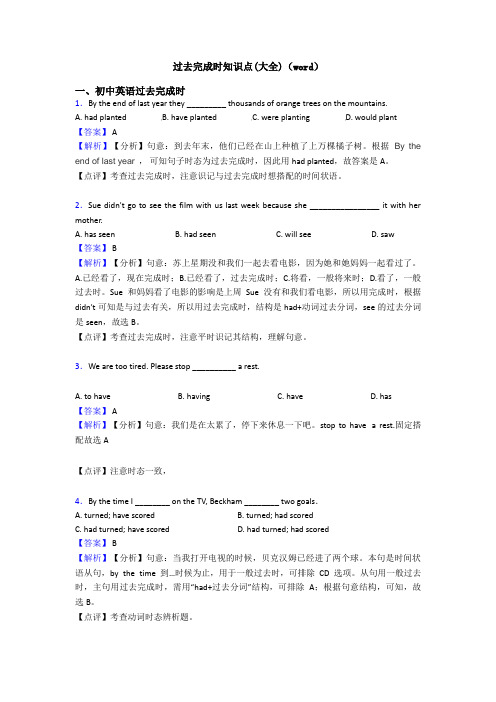
过去完成时知识点(大全)(word)一、初中英语过去完成时1.By the end of last year they _________ thousands of orange trees on the mountains. A. had planted B. have planted C. were planting D. would plant【答案】 A【解析】【分析】句意:到去年末,他们已经在山上种植了上万棵橘子树。
根据By the end of last year,可知句子时态为过去完成时,因此用had planted,故答案是A。
【点评】考查过去完成时,注意识记与过去完成时想搭配的时间状语。
2.Sue didn't go to see the film with us last week because she ________________ it with her mother.A. has seenB. had seenC. will seeD. saw【答案】 B【解析】【分析】句意:苏上星期没和我们一起去看电影,因为她和她妈妈一起看过了。
A.已经看了,现在完成时;B.已经看了,过去完成时;C.将看,一般将来时;D.看了,一般过去时。
Sue和妈妈看了电影的影响是上周Sue没有和我们看电影,所以用完成时,根据didn't可知是与过去有关,所以用过去完成时,结构是had+动词过去分词,see的过去分词是seen,故选B。
【点评】考查过去完成时,注意平时识记其结构,理解句意。
3.We are too tired. Please stop __________ a rest.A. to haveB. havingC. haveD. has【答案】 A【解析】【分析】句意:我们是在太累了,停下来休息一下吧。
stop to have a rest.固定搭配故选A【点评】注意时态一致,4.By the time I ________ on the TV, Beckham ________ two goals.A. turned; have scoredB. turned; had scoredC. had turned; have scoredD. had turned; had scored【答案】 B【解析】【分析】句意:当我打开电视的时候,贝克汉姆已经进了两个球。
过去完成时知识点详解(初中英语专项复习) (7)

过去完成时知识点详解(初中英语专项复习)过去完成时是什么过去完成时(The Past Perfect Tense):表示过去某一时间或动作以前已经发生或完成了的动作,对过去的某一点造成的某种影响或是结果,用来指在另一个过去行动之前就已经完成了的事件。
它表示动作发生的时间是“过去的过去”,侧重事情的结果。
一、概念:表示过去的过去,其构成是had +过去分词。
1.肯定句:主语+had+动词过去分词+其他.2.否定句:主语+had+not+动词过去分词+其他.3.疑问句:Had+主语+动词过去分词+其他?肯定回答:Yes,主语+had.否定回答:No,主语+hadn't.4.特殊疑问句:特殊疑问词或词组+had+主语+过去分词+其他?5.被动语态:主语+had(not) +been+动词过去分词+其他.二、用法:1.表示某一动作在过去某一时刻之前已完成。
例如:He had gone to bed by 10:00 last night. (昨夜十点钟之前他已上床去睡了。
)2.与一般过去时搭配,表达某一动作在过去的动作发生时已完成。
例如:The train had started when I got to the station. (当我到达车站时火车已开走了。
)The minute I saw a lady getting off the bus, I knew it was she, for I had seen her before. (我一看到正在下公共汽车的那位女士就知道是她,因为我以前看见过她。
)解说:使用过去完成时在简单句里表达某一动作在过去的某一时刻已完成时,该过去的时刻常以“by +过去时间”的短语来表达。
例如下面的说法是不正确的:He had gone to bed at 10:00 last night.若是要说“at 10:00 last night”就必须用一般过去时“He went to bed...”。
过去完成时知识点详解(初中英语专项复习) (2)
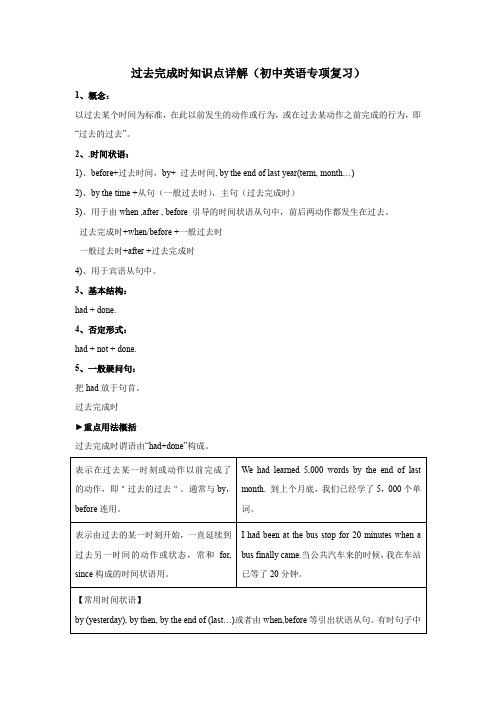
过去完成时知识点详解(初中英语专项复习)
1、概念:
以过去某个时间为标准,在此以前发生的动作或行为,或在过去某动作之前完成的行为,即“过去的过去”。
2、.时间状语:
1)、before+过去时间,by+ 过去时间, by the end of last year(term, month…)
2)、by the time +从句(一般过去时),主句(过去完成时)
3)、用于由when ,after , before 引导的时间状语从句中,前后两动作都发生在过去。
过去完成时+when/before +一般过去时
一般过去时+after +过去完成时
4)、用于宾语从句中。
3、基本结构:
had + done.
4、否定形式:
had + not + done.
5、一般疑问句:
把had放于句首。
过去完成时
►重点用法概括
过去完成时谓语由“had+done”构成。
过去完成时知识点(大全)
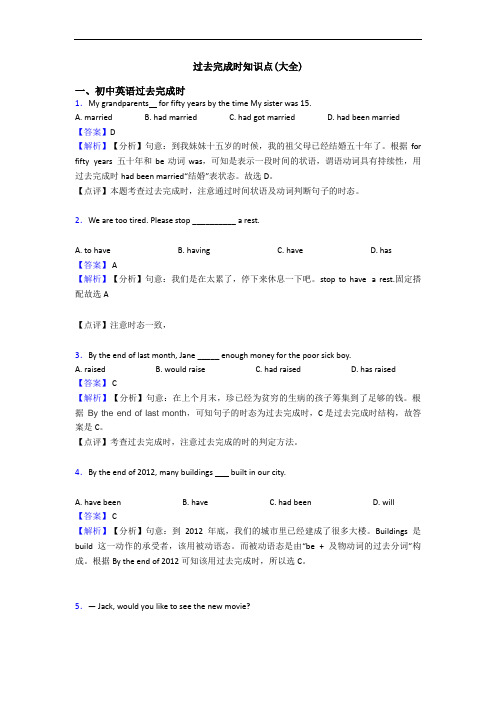
过去完成时知识点(大全)一、初中英语过去完成时1.My grandparents for fifty years by the time My sister was 15.A. marriedB. had marriedC. had got marriedD. had been married【答案】D【解析】【分析】句意:到我妹妹十五岁的时候,我的祖父母已经结婚五十年了。
根据for fifty years 五十年和be动词was,可知是表示一段时间的状语,谓语动词具有持续性,用过去完成时had been married“结婚”表状态。
故选D。
【点评】本题考查过去完成时,注意通过时间状语及动词判断句子的时态。
2.We are too tired. Please stop __________ a rest.A. to haveB. havingC. haveD. has【答案】 A【解析】【分析】句意:我们是在太累了,停下来休息一下吧。
stop to have a rest.固定搭配故选A【点评】注意时态一致,3.By the end of last month, Jane _____ enough money for the poor sick boy.A. raisedB. would raiseC. had raisedD. has raised【答案】 C【解析】【分析】句意:在上个月末,珍已经为贫穷的生病的孩子筹集到了足够的钱。
根据By the end of last month,可知句子的时态为过去完成时,C是过去完成时结构,故答案是C。
【点评】考查过去完成时,注意过去完成的时的判定方法。
4.By the end of 2012, many buildings built in our city.A. have beenB. haveC. had beenD. will【答案】 C【解析】【分析】句意:到2012年底,我们的城市里已经建成了很多大楼。
过去完成时知识点归纳与总结
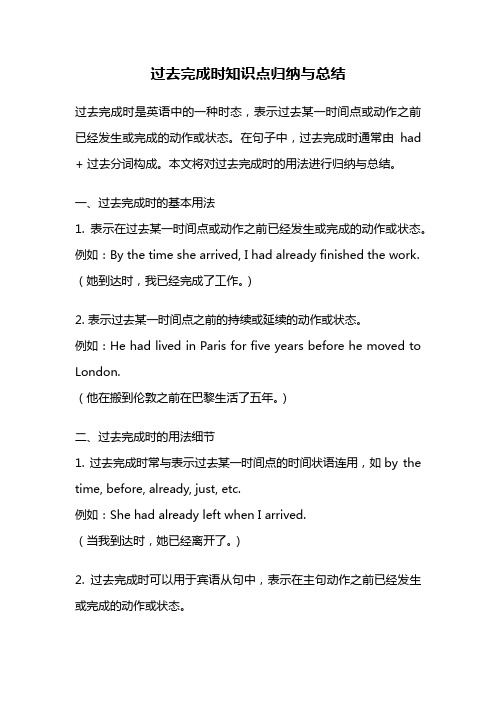
过去完成时知识点归纳与总结过去完成时是英语中的一种时态,表示过去某一时间点或动作之前已经发生或完成的动作或状态。
在句子中,过去完成时通常由had + 过去分词构成。
本文将对过去完成时的用法进行归纳与总结。
一、过去完成时的基本用法1. 表示在过去某一时间点或动作之前已经发生或完成的动作或状态。
例如:By the time she arrived, I had already finished the work.(她到达时,我已经完成了工作。
)2. 表示过去某一时间点之前的持续或延续的动作或状态。
例如:He had lived in Paris for five years before he moved to London.(他在搬到伦敦之前在巴黎生活了五年。
)二、过去完成时的用法细节1. 过去完成时常与表示过去某一时间点的时间状语连用,如by the time, before, already, just, etc.例如:She had already left when I arrived.(当我到达时,她已经离开了。
)2. 过去完成时可以用于宾语从句中,表示在主句动作之前已经发生或完成的动作或状态。
例如:I didn't know that she had already seen the movie.(我不知道她已经看过这部电影。
)3. 过去完成时可以用于条件句中,表示与过去某一时间点相反的假设情况。
例如:If I had known you were coming, I would have prepared dinner.(如果我知道你要来,我会准备晚餐的。
)4. 过去完成时可以用于间接引语中,表示在引述的过去时间点之前已经发生或完成的动作或状态。
例如:She told me that she had already finished her homework.(她告诉我她已经完成了作业。
过去完成时知识点(大全)
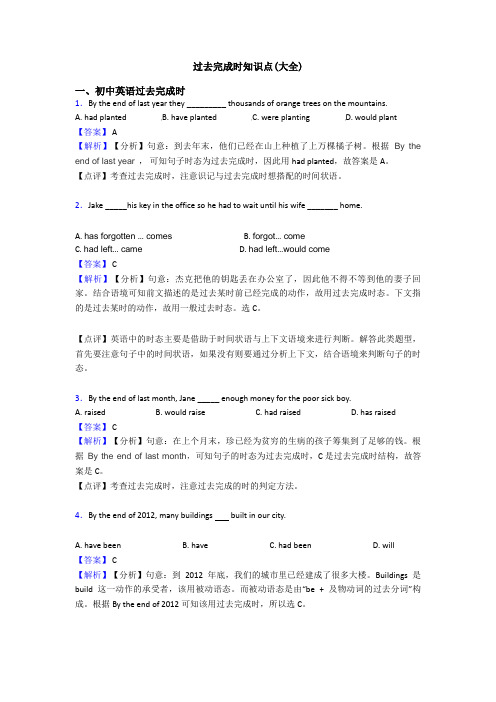
过去完成时知识点(大全)一、初中英语过去完成时1.By the end of last year they _________ thousands of orange trees on the mountains. A. had planted B. have planted C. were planting D. would plant【答案】 A【解析】【分析】句意:到去年末,他们已经在山上种植了上万棵橘子树。
根据By the end of last year,可知句子时态为过去完成时,因此用had planted,故答案是A。
【点评】考查过去完成时,注意识记与过去完成时想搭配的时间状语。
2.Jake _____his key in the office so he had to wait until his wife _______ home.A. has forgotten … comesB. forgot… comeC. had left… cameD. had left…would come【答案】 C【解析】【分析】句意:杰克把他的钥匙丢在办公室了,因此他不得不等到他的妻子回家。
结合语境可知前文描述的是过去某时前已经完成的动作,故用过去完成时态。
下文指的是过去某时的动作,故用一般过去时态。
选C。
【点评】英语中的时态主要是借助于时间状语与上下文语境来进行判断。
解答此类题型,首先要注意句子中的时间状语,如果没有则要通过分析上下文,结合语境来判断句子的时态。
3.By the end of last month, Jane _____ enough money for the poor sick boy.A. raisedB. would raiseC. had raisedD. has raised【答案】 C【解析】【分析】句意:在上个月末,珍已经为贫穷的生病的孩子筹集到了足够的钱。
根据By the end of last month,可知句子的时态为过去完成时,C是过去完成时结构,故答案是C。
初中英语知识点过去完成时

初中英语知识点过去完成时:过去完成时表示在过去某个时间或动作之前已经完成的动作或状态。
构成:had + 过去分词肯定句:主语+ had + 过去分词+ 其他否定句:主语+ had not + 过去分词+ 其他疑问句:Had + 主语+ 过去分词+ 其他?例如:肯定句:I had finished my homework before my mother came back.否定句:She had not seen the movie before yesterday.疑问句:Had you ever been to Beijing before you moved there?注意事项:1. 过去完成时常与过去时连用,表示先后发生的两个动作。
2. 过去完成时常与时间状语连用,如before, by, until等。
3. 过去完成时常用于宾语从句、时间状语从句和条件状语从句中。
例题:1. —When did you finish your homework?—I ______ it before dinner.A. finishedB. have finishedC. had finishedD. will finish答案:C2. By the time we got to the cinema, the film ______.A. has startedB. had startedC. was startingD. would start答案:B3. She ______ her work before she went to bed last night.A. finishedB. has finishedC. had finishedD. will finish答案:C4. I ______ the book before I returned it to the library.A. have readB. had readC. will readD. am reading答案:B5. He ______ his breakfast before he went to school this morning.A. finishedB. has finishedC. had finishedD. will finish 答案:C。
过去完成时知识点归纳与总结
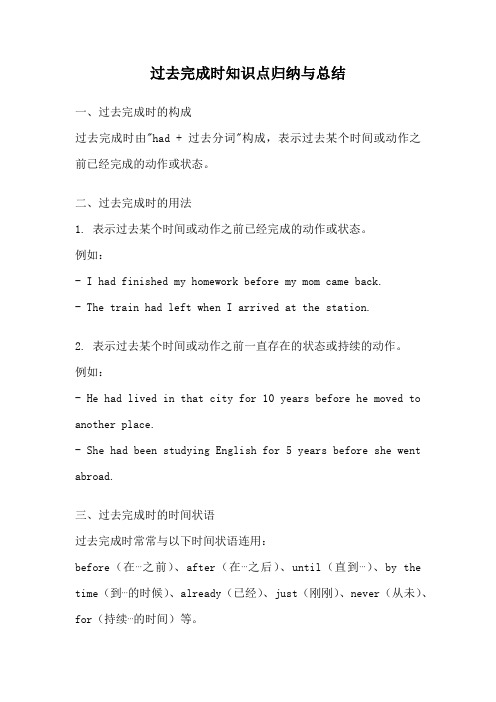
过去完成时知识点归纳与总结一、过去完成时的构成过去完成时由"had + 过去分词"构成,表示过去某个时间或动作之前已经完成的动作或状态。
二、过去完成时的用法1. 表示过去某个时间或动作之前已经完成的动作或状态。
例如:- I had finished my homework before my mom came back.- The train had left when I arrived at the station.2. 表示过去某个时间或动作之前一直存在的状态或持续的动作。
例如:- He had lived in that city for 10 years before he moved to another place.- She had been studying English for 5 years before she went abroad.三、过去完成时的时间状语过去完成时常常与以下时间状语连用:before(在⋯之前)、after(在⋯之后)、until(直到⋯)、by the time(到⋯的时候)、already(已经)、just(刚刚)、never(从未)、for(持续⋯的时间)等。
例如:- I had already finished my breakfast when they arrived.- They had never been to that city before they went there last month.四、过去完成时的注意事项1. 过去完成时表示的动作或状态必须发生在过去某个时间或动作之前。
2. 过去完成时一般用于复合句中,常与过去的时间状语连用。
3. 若主句是过去时态,从句中的动作通常使用过去完成时。
4. 若主句是现在时态,从句中的动作通常使用现在完成时。
五、过去完成时与其他时态的区别1. 过去完成时与一般过去时的区别:过去完成时强调过去某个时间或动作之前已经完成的动作或状态,而一般过去时则只表示过去发生的动作或状态。
过去完成时知识点归纳与总结

过去完成时知识点归纳与总结一、过去完成时的构成过去完成时是由助动词"had"和动词的过去分词形式构成的。
动词的过去分词形式通常是在动词原形后加上-ed。
例如:"had seen","had eaten"。
二、过去完成时的用法1. 表示在过去某个时间或动作之前已经发生或完成的动作。
例如:"She had already left when I called her."意思是"在我给她打电话的时候,她已经离开了。
"2. 表示过去某个时间点之前一直持续的动作或状态。
例如:"I had known him for years before he moved away."意思是"在他搬走之前,我认识他已经有很多年了。
"3. 表示对过去某个动作的猜测或假设。
例如:"He had probably gone to bed when I arrived."意思是"当我到达时,他可能已经上床睡觉了。
"4. 与"if only"连用,表示对过去某个动作的遗憾或后悔。
例如:"If only I had studied harder, I would have passed the exam."意思是"要是我当时学得更努力一些,我就能通过考试了。
"三、过去完成时的标志词过去完成时的常见标志词有:"already","just","before","when","after","by the time","until"等。
四、过去完成时与其他时态的区别1. 过去完成时与一般过去时的区别:过去完成时表示在过去某个时间或动作之前已经发生或完成的动作,强调先后顺序;而一般过去时则仅表示过去的动作或状态,没有先后顺序的含义。
高一英语过去完成时知识点
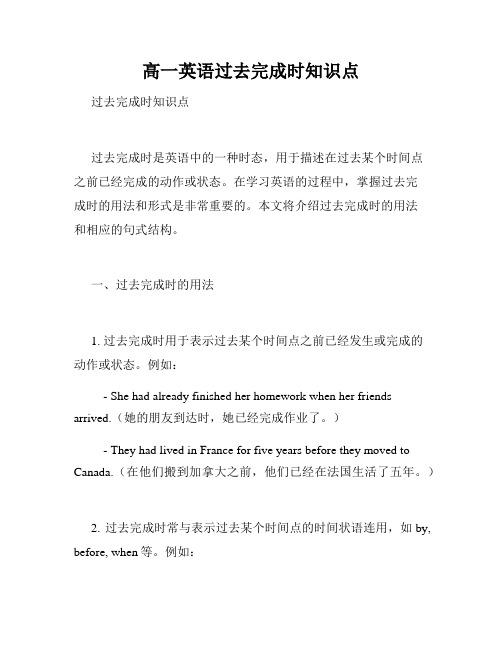
高一英语过去完成时知识点过去完成时知识点过去完成时是英语中的一种时态,用于描述在过去某个时间点之前已经完成的动作或状态。
在学习英语的过程中,掌握过去完成时的用法和形式是非常重要的。
本文将介绍过去完成时的用法和相应的句式结构。
一、过去完成时的用法1. 过去完成时用于表示过去某个时间点之前已经发生或完成的动作或状态。
例如:- She had already finished her homework when her friends arrived.(她的朋友到达时,她已经完成作业了。
)- They had lived in France for five years before they moved to Canada.(在他们搬到加拿大之前,他们已经在法国生活了五年。
)2. 过去完成时常与表示过去某个时间点的时间状语连用,如by, before, when等。
例如:- He had already left by the time I arrived.(当我到达时,他已经离开了。
)- They had finished the project before the deadline.(在截止日期之前,他们已经完成了这个项目。
)3. 过去完成时还可用于表示过去某个时间点之前的条件或假设。
例如:- If I had known about the party, I would have attended.(如果我当时知道有这个派对,我就会参加。
)- He would have passed the exam if he had studied harder.(如果他学习更努力,他会通过考试的。
)二、过去完成时的句式结构过去完成时的句子由"had + 过去分词"构成。
其中,"had"是过去完成时的助动词,用于表示完成的动作或状态;过去分词表示动作的完成形式。
以下是几种常见的过去完成时的句式结构:1. 肯定句:主语 + had + 过去分词- I had finished my work.- They had already left.2. 否定句:主语 + hadn't + 过去分词- She hadn't seen the movie before.3. 疑问句:Had + 主语 + 过去分词 + 其他? - Had you finished your homework?- Had they arrived when you called?4. 肯定回答:Yes, 主语 + had.- Yes, I had finished my work.5. 否定回答:No, 主语 + hadn't.- No, she hadn't seen the movie before.三、过去完成时的注意事项1. 过去完成时通常与过去时间相关,可以使用时间状语词或从句指明过去的时间点。
过去完成时知识点总结
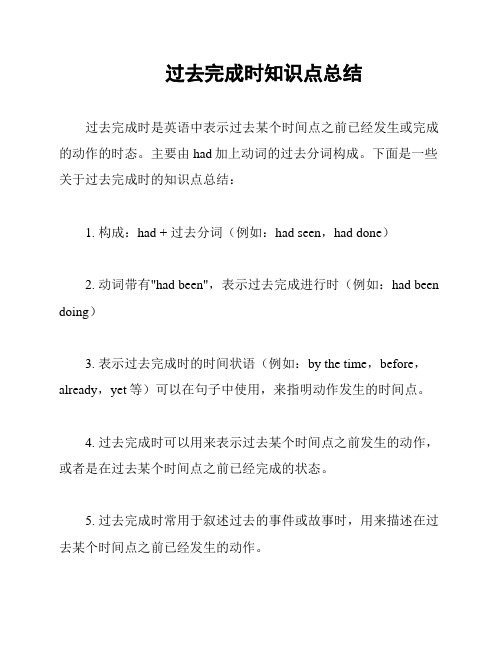
过去完成时知识点总结
过去完成时是英语中表示过去某个时间点之前已经发生或完成的动作的时态。
主要由had加上动词的过去分词构成。
下面是一些关于过去完成时的知识点总结:
1. 构成:had + 过去分词(例如:had seen,had done)
2. 动词带有"had been",表示过去完成进行时(例如:had been doing)
3. 表示过去完成时的时间状语(例如:by the time,before,already,yet等)可以在句子中使用,来指明动作发生的时间点。
4. 过去完成时可以用来表示过去某个时间点之前发生的动作,或者是在过去某个时间点之前已经完成的状态。
5. 过去完成时常用于叙述过去的事件或故事时,用来描述在过去某个时间点之前已经发生的动作。
以下是一些例句来帮助理解过去完成时的用法:
- Before I arrived at the party, they had already eaten all the food.
在我到达派对之前,他们已经吃完了所有的食物。
- I had been waiting for the bus for over an hour when it finally arrived.
当公交车终于到达时,我已经等了一个多小时了。
- By the time I woke up, my parents had already left for work.
在我醒来的时候,我的父母已经去上班了。
希望以上内容对你有帮助!。
(知识点)掌握过去完成时的用法和句型

(知识点)掌握过去完成时的用法和句型过去完成时是英语中的一种时态,表示过去某一时间点或动作之前已经完成的动作或情况。
它通常由“had + 过去分词”构成。
一、过去完成时的基本用法1. 表示过去某一时间点之前已经完成的动作或情况。
例如:- When I arrived at the party, the cake had already been eaten.(当我到达派对时,蛋糕已经被吃完了。
)- They had left before I came.(在我来之前,他们已经离开了。
)2. 表示过去某一时间段内已经完成的动作或情况。
例如:- By the time we got to the theater, the movie had started.(当我们到达剧院的时候,电影已经开始了。
)- She had read ten pages of the book before she fell asleep.(她在睡着之前已经读了十页书。
)3. 用于虚拟语气中,表示过去对现在发生的动作或情况进行推测或假设。
例如:- If she had studied harder, she would have passed the exam.(如果她努力学习的话,她就能通过考试。
)- I wish I had known about the event earlier.(我希望我早点知道这个事件。
)二、过去完成时的句型1. 肯定句型:主语 + had + 过去分词+ …例如:- He had finished his homework before he went to bed.(他睡觉前已经完成了他的作业。
)2. 否定句型:主语 + hadn't + 过去分词+ …例如:- The train hadn't arrived when we left the station.(当我们离开车站时,火车还没有到。
分钟搞定过去完成时的关键知识点

分钟搞定过去完成时的关键知识点过去完成时是英语中的一种时态,用于表示在过去某一时间之前已经发生或完成的动作或状态。
在学习过去完成时时,掌握关键知识点是非常重要的。
本文将介绍分钟搞定过去完成时的关键知识点,帮助读者更好地理解和运用这一时态。
过去完成时的构成过去完成时的构成通常是由had + 过去分词构成的。
例如:- I had finished my homework before my mom came back.- She had already left when I arrived at the station.过去完成时的用法1. 表示在过去某一时间之前已经发生的动作或状态。
例如:- By the time I woke up, my sister had already gone to school.- He realized he had left his keys at home when he arrived at the office.2. 用于时间状语从句中,表示在过去某一时间之前已经发生的动作或状态。
例如:- He said he had never been to Paris before he visited last summer.- I knew I had met her somewhere, but I couldn't remember where.3. 表示过去某一时间之前一直持续的动作或状态。
例如:- She had lived in that house for 10 years before she moved to a new city.- He had worked at the company for 5 years when he decided to quit.4. 用于虚拟语气句型中,表示对过去的假设或推测。
例如:- If I had known you were coming, I would have prepared dinner.- She wished she had studied harder for the exam.过去完成时的注意事项1. 过去完成时通常与表示过去某一具体时间的时间状语连用,如:by the time, before, after等。
高中英语知识点归纳动词的过去完成时

高中英语知识点归纳动词的过去完成时动词的过去完成时是英语语法中的一个时态,用来表示过去某个时间点之前已经完成的动作或状态。
掌握动词的过去完成时的用法对于高中英语学习非常重要。
本文将对动词的过去完成时进行归纳总结,帮助读者更好地理解和运用该时态。
一、概述过去完成时的构成:had + 过去分词过去完成时的用法:表示过去某个时间点之前已经完成的动作或状态二、过去完成时的基本用法1. 表示过去某个时间点之前已经完成的动作。
例如:- By the time I arrived, they had already left.(我到达时,他们已经走了。
)- The train had left before I got to the station.(我到车站时,火车已经开走了。
)2. 表示过去某个时间点之前已经从事过的动作或经历过的状态。
例如:- She had studied French for five years before moving to Paris.(她在去巴黎之前已经学习了五年法语。
)- He had seen that movie three times before it was released.(在电影上映之前,他已经看了三次那部电影。
)三、过去完成时与其他时态的区别与联系1. 过去完成时与过去时的区别:- 过去完成时强调在过去某个时间点之前已经完成的动作或状态,过去时只表示过去的动作或状态。
- 过去完成时常常与表示过去某个时间点的时间状语连用,强调两个动作的先后关系。
2. 过去完成时与过去进行时的区别:- 过去完成时强调在过去某个时间点之前已经完成的动作或状态,过去进行时表示在过去某个时间点正在进行的动作。
- 过去完成时常常与表示过去某个时间点的时间状语连用,强调过去完成的动作发生在过去进行的动作之前。
3. 过去完成时与一般过去时的区别:- 过去完成时强调在过去某个时间点之前已经完成的动作或状态,一般过去时只表示过去的动作或状态。
【英语】过去完成时知识点(大全)(word)
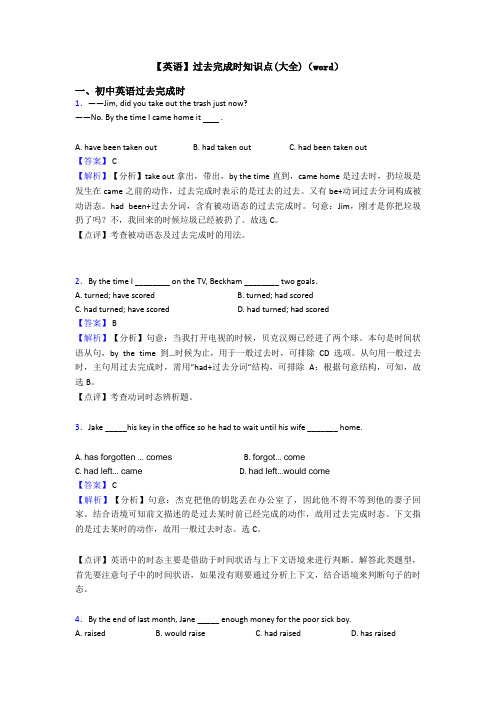
【英语】过去完成时知识点(大全)(word)一、初中英语过去完成时1.——Jim, did you take out the trash just now?——No. By the time I came home it .A. have been taken outB. had taken outC. had been taken out【答案】 C【解析】【分析】take out拿出,带出,by the time直到,came home是过去时,扔垃圾是发生在came之前的动作,过去完成时表示的是过去的过去。
又有be+动词过去分词构成被动语态。
had been+过去分词,含有被动语态的过去完成时。
句意:Jim,刚才是你把垃圾扔了吗?不,我回来的时候垃圾已经被扔了。
故选C。
【点评】考查被动语态及过去完成时的用法。
2.By the time I ________ on the TV, Beckham ________ two goals.A. turned; have scoredB. turned; had scoredC. had turned; have scoredD. had turned; had scored【答案】 B【解析】【分析】句意:当我打开电视的时候,贝克汉姆已经进了两个球。
本句是时间状语从句,by the time到…时候为止,用于一般过去时,可排除CD选项。
从句用一般过去时,主句用过去完成时,需用“had+过去分词”结构,可排除A;根据句意结构,可知,故选B。
【点评】考查动词时态辨析题。
3.Jake _____his key in the office so he had to wait until his wife _______ home.A. has forgotten … comesB. forgot… comeC. had left… cameD. had left…would come【答案】 C【解析】【分析】句意:杰克把他的钥匙丢在办公室了,因此他不得不等到他的妻子回家。
最新过去完成时知识点(大全)(word)

最新过去完成时知识点(大全)(word)一、初中英语过去完成时1.—Did you see Tom at the party?—No, he by the time I got there.A. leftB. was leavingC. had leftD. has left【答案】 C【解析】【分析】by the time的从句用过去时,主句用过去完成时,表示主句的动作先发生,故选C。
句意是:在我到那里之前他已经离开了。
【点评】本题考查过去完成时的用法。
2.Simon ________ the piano for ages when he gave his first concert.A. has playedB. is playingC. had playedD. will play【答案】 C【解析】【分析】句意:西蒙举行第一次音乐会时,他已经弹了很多年钢琴了。
根据时间状语when he gave his first concert.可知此处用过去的时态,表示先弹钢琴弹了很多年,然后开了音乐会,表示过去的过去,应该用过去完成时:had+动词的过去分词,故答案为C。
【点评】考查过去完成时。
掌握过去完成时的意义(过去的过去)和构成:had+动词的过去分词。
3.Sue didn't go to see the film with us last week because she ________________ it with her mother.A. has seenB. had seenC. will seeD. saw【答案】 B【解析】【分析】句意:苏上星期没和我们一起去看电影,因为她和她妈妈一起看过了。
A.已经看了,现在完成时;B.已经看了,过去完成时;C.将看,一般将来时;D.看了,一般过去时。
Sue和妈妈看了电影的影响是上周Sue没有和我们看电影,所以用完成时,根据didn't可知是与过去有关,所以用过去完成时,结构是had+动词过去分词,see的过去分词是seen,故选B。
过去完成时知识点(大全)含答案
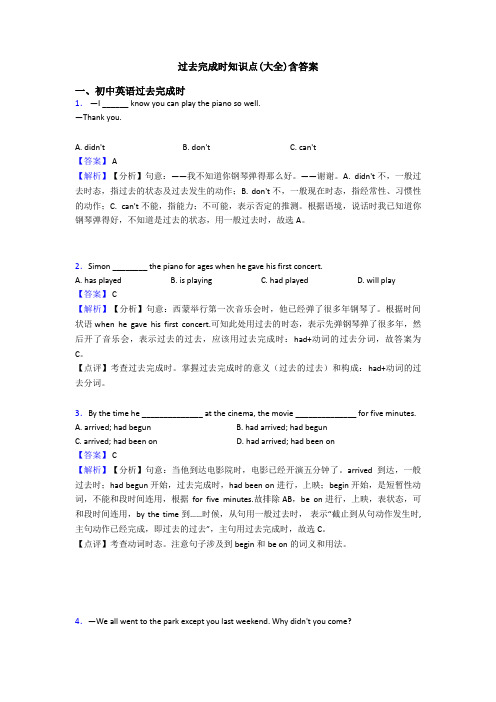
过去完成时知识点(大全)含答案一、初中英语过去完成时1.—I ______ know you can play the piano so well.—Thank you.A. didn'tB. don'tC. can't【答案】 A【解析】【分析】句意:——我不知道你钢琴弹得那么好。
——谢谢。
A. didn't不,一般过去时态,指过去的状态及过去发生的动作;B. don't不,一般现在时态,指经常性、习惯性的动作;C. can't不能,指能力;不可能,表示否定的推测。
根据语境,说话时我已知道你钢琴弹得好,不知道是过去的状态,用一般过去时,故选A。
2.Simon ________ the piano for ages when he gave his first concert.A. has playedB. is playingC. had playedD. will play【答案】 C【解析】【分析】句意:西蒙举行第一次音乐会时,他已经弹了很多年钢琴了。
根据时间状语when he gave his first concert.可知此处用过去的时态,表示先弹钢琴弹了很多年,然后开了音乐会,表示过去的过去,应该用过去完成时:had+动词的过去分词,故答案为C。
【点评】考查过去完成时。
掌握过去完成时的意义(过去的过去)和构成:had+动词的过去分词。
3.By the time he ______________ at the cinema, the movie ______________ for five minutes.A. arrived; had begunB. had arrived; had begunC. arrived; had been onD. had arrived; had been on【答案】 C【解析】【分析】句意:当他到达电影院时,电影已经开演五分钟了。
- 1、下载文档前请自行甄别文档内容的完整性,平台不提供额外的编辑、内容补充、找答案等附加服务。
- 2、"仅部分预览"的文档,不可在线预览部分如存在完整性等问题,可反馈申请退款(可完整预览的文档不适用该条件!)。
- 3、如文档侵犯您的权益,请联系客服反馈,我们会尽快为您处理(人工客服工作时间:9:00-18:30)。
过去完成时的用法
1.过去完成时表示一个动作或状态在过去某一时间或动作之前已经完成或结束,即发生在
"过去的过去"。
如:When I woke up, it had stopped raining.
我醒来时,雨已经停了。
(主句的动作发生在"过去的过去")
2. 过去完成时是一个相对的时态,表示的是"过去的过去",只有和过去某一时间或某一动作相比较时才使用它。
如:He told me that he had written a new book. (had written 发生在told 之前)
3. 过去完成时需要与一个表示过去的时间状语连用,它不能离开过去时间而独立存在。
此时多与already ,yet ,still ,just ,before ,never 等时间副词及by ,before ,until 等引导的短语或从句连用。
如:Before she came to China, Grace had taught English in a middle school for about five years. Peter had collected more than 300 Chinese stamps by the time he was ten.
4. 过去完成时表示某一动作或状态在过去某时之前已经开始,一直延续到这一过去时间,而且动作尚未结束,仍然有继续下去的可能。
如:By the end of last year, he had worked in the factory for twenty years. (had worked 已有了20 年,还有继续进行下去的可能)
过去完成时的基本用法
过去完成时与现在完成时相似,也有“已完成”和“未完成”两种用法,所不同的是,过去完成时将时间推移到过去某一时间之前,即所谓的“过去的过去”。
具体地说,它既可表示在过去某一时间之前已完成的动作,也可表示从一个较早的过去持续一个较迟的过去的动作:He had left when I arrived. 当我到达时他已经离开。
By six o’clock he had worked twelve hours. 到6点钟时他就已工作了12小时。
过去完成时根据上下文来判定
根据上、下文来判定。
I met Wang Tao in the street yesterday. We hadn't seen each other since he went to Beijing
过去完成时与一般过去时的区别
虽然这两种时态都表示过去发生的动作或存在的状态,但在使用时应注意以下几点:
1. 时间状语不同:过去完成时在时间上强调"过去的过去";而一般过去时只强调过去某一特定的时间。
试比较:
They had arrived at the station by ten yesterday.
They arrived at the station at ten yesterday.
2. 在没有明确的过去时间状语作标志时,谓语动词动作发生的时间先后须依据上下文来判断:先发生的用过去完成时,后发生的则用一般过去时。
如:She was very happy. Her whole family were pleased with her, too. She had just won the first in the composition competition.
3. 当两个或两个以上接连发生的动作用and 或but 连接时,按时间顺序,只需用一般过去时来代替过去完成时;另外,在before ,after ,as soon as 引导的从句中,由于这些连词本身已经表示出时间的先后,因此也可以用过去时来代替过去完成时。
如:He entered the room, turned on the light and read an evening paper.
I (had) called her before I left the office.
过去完成时与现在完成时的区别
现在完成时表示的动作发生在过去,但侧重对现在产生的结果或造成的影响,与现在有关,其结构为"助动词have (has) + 过去分词";过去完成时则是一个相对的时态,它所表示的动作不仅发生在过去,更强调"过去的过去",只有和过去某时或某动作相比较时,才用到它。
试比较:I have learned 1000 English words so far.
到目前为止我已经学会了1000 个英语单词。
I had learned 1000 English words till then.
到那时为止我已经学会了1000 个英语单词。
- I'm sorry to keep you waiting. 对不起,让你久等了。
- Oh, not at all. I have been here only a few minutes.
没什么,我只等了几分钟。
("等"的动作从过去某一时间点持续到现在)
- John returned home yesterday. 约翰昨天回到家的。
- Where had he been?
他去哪儿了?(答语中使用过去完成时是指约翰在returned home 之前去了哪些地方,即"过去的过去")
过去完成时由过去的过去来判定
过去完成时表示"过去的过去",是指过去某一动作之前已经发生或完成的动作,即动作有先后关系,动作在前的用过去完成时,在后的用一般过去时。
这种用法常出现在:
(1 )宾语从句中
当宾语从句的主句为一般过去时,且从句的动作先于主句的动作时,从句要用过去完成时。
在told, said, knew, heard, thought等动词后的宾语从句。
如:She said that she had seen the film before.
(2 )状语从句中
在时间、条件、原因、方式等状语从句中,主、从句的动作发生有先后关系,动作在前的,要用过去完成时,动作在后的要用一般过去时。
如:When I got to the station, the train had already left.
After he had finished his homework, he went to bed.
注意:before, after 引导的时间状语从句中,由于before 和after 本身已表达了动作的先后关系,若主、从句表示的动作紧密相连,则主、从句都用一般过去时。
如:Where did you study before you came here?
After he closed the door, he left the classroom.
(3 )表示意向的动词,如hope, wish, expect, think, intend, mean, suppose等,用过去完成时表示"原本…,未能…"
We had hoped that you would come, but you didn't.
过去完成时由时间状语来判定
一般说来,各种时态都有特定的时间状语。
与过去完成时连用的时间状语有:
(1 )by + 过去的时间点。
如:I had finished reading the novel by nine o'clock last night.
(2 )by the end of + 过去的时间点。
如:We had learned over two thousand English words by the end of last term.
(3 )before + 过去的时间点。
如:They had planted six hundred trees before last Wednesday.。
